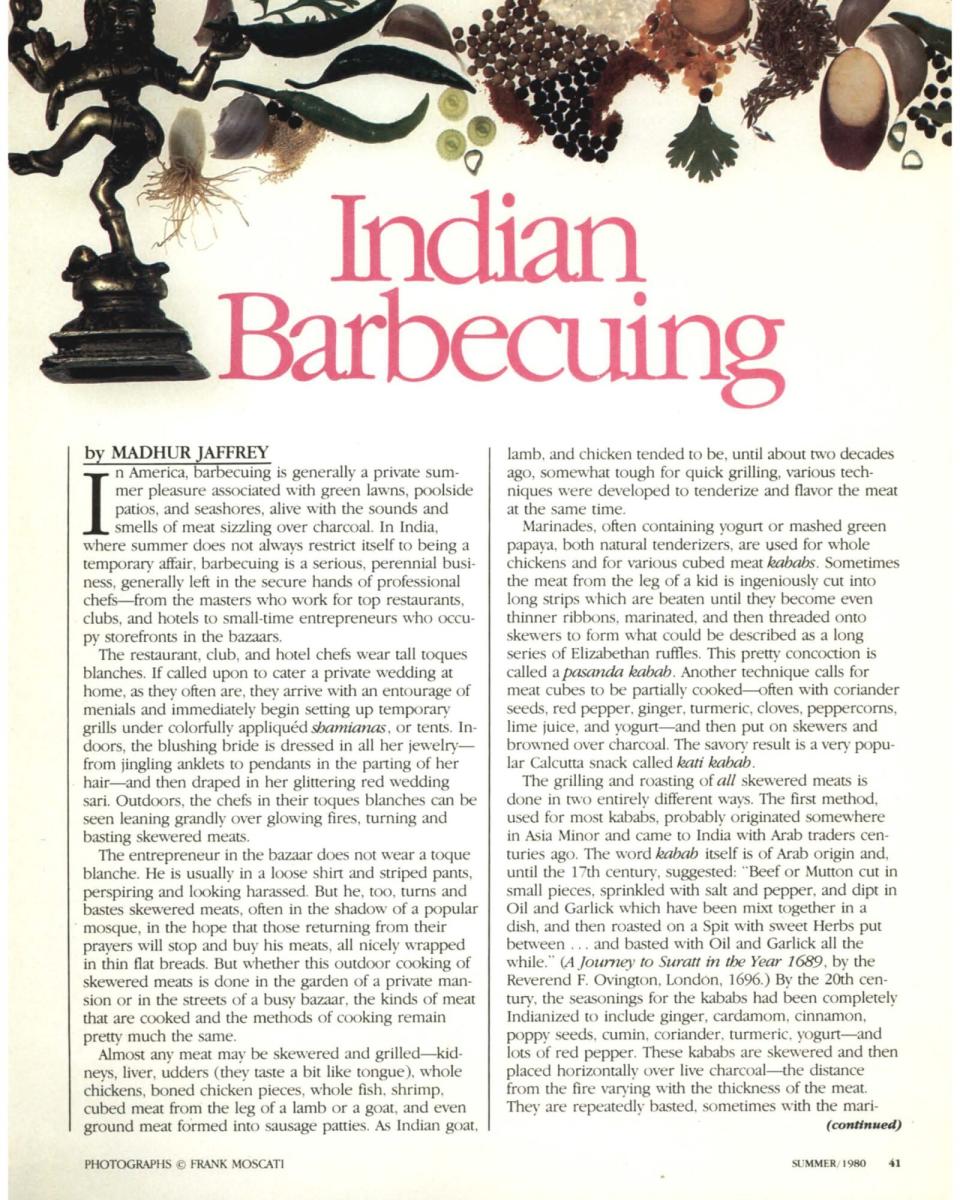A Lesson in Live-Fire Cooking from the Legendary Madhur Jaffrey

Paul Zimmerman / Getty Images
Editor's note: Food & Wine had its eyes trained on Madhur Jaffrey since nearly the beginning, logging her as a bold-faced name at star-studded food world parties as early as October 1978. Finally in the summer of 1980, the magazine managed to score a full-length feature from the superstar actress, author, chef, and culinary ambassador, delving into one of her favorite subjects: the art and craft of Indian barbecuing.
In America, barbecuing is generally a private summer pleasure associated with green lawns, poolside patios, and seashores, alive with the sounds and smells of meat sizzling over charcoal. In India, where summer does not always restrict itself to being a temporary affair, barbecuing is a serious, perennial business, generally left in the secure hands of professional chefs — from the masters who work for top restaurants, clubs, and hotels to small-time entrepreneurs who occupy storefronts in the bazaars.
The restaurant, club, and hotel chefs wear tall toque blanches. If called upon to cater a private wedding at home, as they often are, they arrive with an entourage of helpers and immediately begin setting up temporary grills under colorfully appliquéd shamianas, or tents, Indoors, the blushing bride is dressed in all her jewelry — from jingling anklets to pendants in the parting of her hair — and then draped in her glittering red wedding sari. Outdoors, the chefs in their toque blanches can be seen leaning grandly over glowing fires, turning and basting skewered meats.
RELATED: The Seekh Kebab Is an All-Time Barbecue Great

The entrepreneur in the bazaar does not wear a toque blanche. He is usually in a loose shirt and striped pants, perspiring and looking harassed. But he, too, turns and bastes skewered meats, often in the shadow of a popular mosque, in the hopes that those returning from their prayer will stop and buy his meats, all nicely wrapped in thin, flat breads. But whether this outdoor cooking of skewered meats is done in the garden of a private mansion or in the streets of a busy bazaar, the kinds of meats that are cooked and the methods of cooking remain pretty much the same.
RELATED: How to Make Mind Blowing Kebabs at Home
Almost any meat may be skewered and grilled — kidneys, liver, udders (they taste a bit like tongue), whole chickens, boned chicken pieces, whole fish, shrimp, cubed meat from the leg of a lamb or a goat, and even ground meat formed into sausage patties. As Indian goat, lamb, and chicken tended to be, until about two decades ago, somewhat tough for quick grilling, various techniques were developed to tenderize and flavor the meat at the same time.
Marinades, often containing yogurt or mashed green papaya, both natural tenderizers, are used for whole chicken and for various cubed meat kababs. Sometimes the meat from the leg of a kid is ingeniously cut into long strips which are beaten until they become even thinner ribbons, marinated, and then threaded onto skewers to form what could be described as a long series of Elizabethan ruffles. This pretty concoction is called apasanda kabab. Another technique calls for meat cubes to be partially cooked — often with coriander seeds, red pepper, ginger, turmeric, cloves, peppercorns, lime juice, and yogurt — and then put on skewers and browned over charcoal. The savory result is a very popular Calcutta snack called kati kabab.
RELATED: Food & Wine's Best Barbecue and Grilling Tips from the '70s, '80s, and '90s
The grilling and roasting of all skewered meats is done in two entirely different ways. The first method, used for most kababs, probably originated somewhere in Asia Minor and came to India with Arab traders centuries ago. The word kabab itself is of Arab origin and, until the 17th century, suggested: "Beef or Mutton cut in small pieces, sprinkled with salt and pepper, and dipt in Oil and Garlick which have been mixt together in a dish, and then roasted on a Spit with sweet Herb put between ... and basted with Oil and Garlick all the while." (A Joumey to Suratt in the Year 1689, by the Reverend F. Ovington, London, 1696.)
RELATED: Madhur's Day in the Sun
By the 20th century, the seasoning for the kababs had been completely Indianized to include ginger, cardamom, cinnamon, poppy seeds. cumin, coriander, turmeric, yogurt — and lots of red pepper. These kababs are skewered and then placed horizontally over live charcoal — -the distance from the fire varying with the thickness of the meat They are repeatedly basted, sometimes with the marinade, sometimes with ghee (clarified butter), and sometimes with secret mixtures that prideful and possessive cooks carry with them to their graves.
Sometimes with secret mixtures that prideful and possessive cooks carry with them to their graves.
Kababs of this kind may be served with pullao (rice pilaf). or rolled inside thin breads like the flat. pliable roomali roti or the parata, a flat. flaky griddle bread made with lots of ghee. Raw onion slices are a traditional accompaniment. Yogurt relishes, often made with roasted eggplant, as well as salads of white radish, cucumber, and tomatoes are on the side.
RELATED: Fried Tandoori Chicken
The second form of skewered cooking is done by pushing the meat-laden skewers vertically inside a very hot clay oven called a tandoor. No basting is necessary as small whole chickens cook in less than 10 minutes. Great heat builds up inside the portly bodies of the tandoors so the meat is instantly seared and all the juices are trapped inside. The quick cooking allows the meat to stay velvety moist while an earlier marinating process ensures its tenderness.
Although it probably originated somewhere in the vicinity of the Caspian Sea, the tandoori style of cooking has been preferred for centuries in the Punjab and in India's former Northwest Frontier Province. Villages used to have centrally located, communal tandoors where housewives could take their marinated meats and their freshly risen dough for cooking.
RELATED: Jhumpa Lahiri's 'Food Suitcase' Brought Calcutta to Rhode Island
Tandoors are shaped like vats with an opening at the top and another at one side of the bottom, through which charcoal or wood are thrust for fuel. Restaurant tandoors are about waist high and are usually embedded in a brick structure to further comerve their heat. Home tandoors, sold in India and in some parts of the United States, are much smaller and — in lndia at any rate — need to be constantly "refreshed" with layers of fresh coals.
RELATED: Luscious Tandoori Lamb Chops
The first time I made tandoori chicken for James Beard, he took one bite and said casually, "This has two marinades, how interesting."
The first time I made tandoori chicken for James Beard. he took one bite and said casually, "This has two marinades, how interesting." With his sharp palate. he knew immediately. A properly made tandoori chicken does indeed. have two marinades — one of just salt and lime juice, and another containing yogurt, onion, garlic, ginger, green chilies, and garam masala (an aromatic spice mixture containing cardamom seeds, cinnamon, nutmeg, cloves, peppercorns, and black cumin seeds). In India, tandoori chicken is either served whole to be torn up and eaten with a tandoori bread called naan (baked by slapping it onto the inside wall of a tandoor), or cut into serving pieces and doused with a quickly made sauce containing butter, tomatoes, cream, ginger, and roasted cumin. The latter is known as Chicken Makhani.
RELATED: Diana Kennedy Shares 8 Recipes from Her Mexican Kitchen
Not all outdoor grilling is done with skewers, however. In Goa's fishing villages, for example, freshly caught mackerel is laid directly over a smoldering fire of dried rice stalks. As the outside skin blackens, the inside is permeated with a delicate "smoked" flavor. The skin is then peeled off, and the now pristine fish is served with a dressing of mild palm vinegar flavored with salt, onions. and red chilies. In Bombay, steaks of the local, pompano-like pomfret are smothered in a fresh green chutney containing Chinese parsley and coconut, wrapped in banana leaves (most of Southern Asia is convinced that banana leaves are far superior to aluminum foil, wax paper, and kitchen parchment) and then "baked'' over a charcoal grill. These steaks, served with rice, are a favorite at banquets. I have tried making this Bombay dish with swordfish and find that it works exceedingly well. Of course, I do compromise by using aluminum foil.

